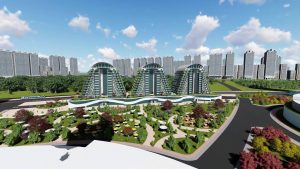 New cities in the Mediterranean of the 19th and 20th centuries (Florence, 2-3 Jul 20)
New cities in the Mediterranean of the 19th and 20th centuries (Florence, 2-3 Jul 20)
The experience of « new cities » and new settlements occupies a prominent place in urban history between the 19th and 20th centuries. Work undertaken in recent years has sought to explain how projects undertaken since the beginning of the 20th century have ended up setting up important multidisciplinary research laboratories in most sectors related to urban planning: from urban planning to architectural design, from new dwelling modes to the creation of public spaces, including the use of water in cities, integrated facilities and transitional housing – but also in sectors more closely linked to social and political history, in the light of new experiences, could provide new and original results.
Different regions bordering the Mediterranean have been places of creation, invention or re-discovery of new worlds closely linked to pre-existing sites and, however, projected towards industrial, agricultural and touristic modernisation, giving rise to new types of population and buildings, reflecting different social, anthropological and cultural conditions that have led to a reflection on the way of working, living and having fun. The « invention » of Mediterranean tourism itself has involved a profound reflection on the forms of hospitality strictly linked to traditional settlement areas.
The recent experience of the regions all around the Mediterranean is plural and not unique. Different contributions, reminiscences, traces, visions contribute to the actual framework we call properly Mediterranean identities.
The western Mediterranean region from Spain, passing through France to Italy, the season after WWII provided the opportunity to reconsider the urban and rural settlements, in a few cases offering the chances for suggesting new worlds, new-towns, new ways of living.
In the Balkan and eastern regions the long wave of the Byzantine-Ottoman colonization affected the human settlements, challenging with the different streams of the modernization, each influencing the others.
In the countries on the southern shore of the Mediterranean, following the establishment of colonisation or protectorate, deep changes affected the fabric, urban form and landscape of existing or newly created Maghreb cities. Such changes were established following the adoption of a settlement policy seeking to strengthen the presence of the French community in the newly conquered territories. The new so-called modern cities, which were established in a position adjacent or distant from the old medinas, were the expression of an ideological, identity, economic, social and touristic representation of their time. These postcolonial creations seek to integrate elements of the repertoire of traditional architecture and North African vernacular heritage.
In their relationship to space, the new cities meet very different requirements:
– fragmenting large congested agglomerations;
– creation of new urban agglomerations born in a position adjacent to former abandoned or neglected centres;
– planning and creation of new tourist centres;
– development of subsoil resources (oil or mining) to compensate for the lack of habitats in the short or medium term, to accommodate both services and workers;
– to shape cities designed to reorganize a given territory, often capitals or important institutional centres.
– development of large parts of the area in which, previously, there was no anthropogenic settlement or stable centres.
The purpose of this meeting is to represent a moment of reflection to discuss, reason and deepen the main architectural themes related to the creation of « new cities » and new districts between the 19th and 20th centuries and, above all, to encourage the exchange of experiences between researchers and teachers from different Mediterranean countries.
The invitation to participate in the Congress extends to all those interested in one of the topics listed below through an oral presentation and/or a poster presentation.
Work areas
1. Colonial cities and new urban architectural structures
2. Urban additions and old cities
3. Founding city and mining cities
4. Tourist areas and their critical interpretations
5. Rural and urban either as opposite or as complementary experiences
Scientific committee
Giulio Barazzetta (POLIMI), Imane Bennani (UIR), Francesco Collotti (DiDA), Lorenzo Ciccarelli (DiDA), Saloua Ferjani (ENAU), Lamia Hadda (DIDA), Saverio Mecca (DiDA), Faouzi Mahfoudh (INP), Mohammed Marzak, Adele Picone (UNINA), Attilio Petruccioli (POLIBA), Marco Rosario Nobile (UNIPA), Ahmed Saadaoui (FLAHM), Giuseppe De Luca (DIDA)
Organization Committee
Saverio Mecca, Francesco Collotti, Lamia Hadda, Saloua Ferjani, Lorenzo Ciccarelli, Alberto Pireddu
To submit a paper it is necessary to send a 300-word abstract as a maximum, with the title, name, affiliation, subject and email of the author(s). Abstracts may be submitted in Italian, English or French and should be sent to one of the following addresses: villesnouvelles2020@gmail.com, no later than 30 April 2020.

Leave a Reply
You must be logged in to post a comment.